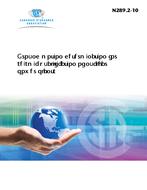CSA N289.2:10 (R2020)
Click here to purchase
Preface:
This is the second edition of CSA N289.2, Ground motion determination for seismic qualification of nuclear power plants. It supersedes the previous edition, published in 1981 under the title Ground Motion Determination for Seismic Qualification of CANDU Nuclear Power Plants. The title has been changed to reflect a scope change, from addressing only CANDU® reactors to including any nuclear power plant.
Note: CANDU (CANada Deuterium Uranium) is a registered trademark of Atomic Energy of Canada Limited (AECL).
Standards in the CSA N289 series of Standards are developed in response to a recognition by the utilities and industries concerned with nuclear facilities in Canada of a need for the documentation of standards applicable to the seismic design and qualification of nuclear structures, systems, and components (SSCs) of nuclear power plants. Although the CSA N289 series of Standards includes regulatory requirements in addition to those of a technical nature, users of this Standard should recognize that it has the force of law only when adopted by the Canadian Nuclear Safety Commission (CNSC) or the appropriate regulatory body (in countries other than Canada).
The CSA N289 series of Standards consists of five Standards. Some of the objectives of each Standard are summarized as follows:
(a) CSA N289.1-08, General requirements for seismic design and qualification of CANDU nuclear power plants — to provide guidelines for identifying structures and systems requiring seismic qualification based on nuclear safety considerations;
(b) CSA N289.2-10, Ground motion determination for seismic qualification of nuclear power plants — to determine the appropriate seismic ground motion parameters for a particular site;
(c) CSA N289.3-10, Design procedures for seismic qualification of nuclear power plants — to provide design requirements and methods
(i) for determining the engineering representation of ground motion, ground response spectra, and floor response spectra for use in the design and seismic qualification of SSCs; and
(ii) for performing seismic qualification of specified SSCs by analytical methods;
(d) CSA CAN3-N289.4-M86 (R2008), Testing procedures for seismic qualification of CANDU nuclear power plants — to provide design requirements and methods for seismic qualification of specific components and systems by testing methods; and
(e) CAN/CSA-N289.5-M91 (R2008), Seismic instrumentation requirements for CANDU nuclear power plants — to establish the requirements for seismic instrumentation and for seismic-related inspection of structures and systems before and after a seismic event.
Users of this Standard are reminded that the design, manufacture, construction, commissioning, operation, and decommissioning of nuclear facilities in Canada are subject to the provisions of the Nuclear Safety and Control Act and its Regulations. Thus, requirements additional to those specified in this Standard may be imposed by the CNSC.
This Standard was prepared by the Subcommittee on Ground Motion Determination for Seismic Qualification of Nuclear Power Plants, under the jurisdiction of the Technical Committee on Seismic Design and the Strategic Steering Committee on Nuclear Standards, and has been formally approved by the Technical Committee.
Scope:
1.1
This Standard describes the investigations required to obtain the seismological and geological information necessary to determine, for a proposed or existing nuclear power plant site, the seismic ground motion that will be used in seismic qualification of safety-related plant structures and systems, and the potential for seismically induced phenomena that can have a direct or indirect effect on plant safety or operation.
Note: CSA N289.2 establishes the basis for a family of seismic hazard results that can be used as input to CSA N289.3.
CSA N289.2 does not specify
a) ground motion parameters to be used in design;
b) probability level; or
c) degree of confidence to be achieved.
1.2
This Standard was developed for the determination of ground motions for regions of low to moderate seismic hazard, comparable to the levels near Canada’s existing nuclear power plants. In regions of higher seismic hazard, the assessment of strong earthquake shaking can be more complex due to near-fault and other effects that are beyond the scope of this Standard. Therefore, while the provisions of this Standard can be applied to any nuclear power plant site, additional provisions might be required for high seismic hazard sites.
Note: Guidance regarding additional provisions for high seismic hazard sites may be obtained from IAEA Safety Standards Series No. NS-G-3.3, and relevant codes of other countries.
1.3
This Standard may be applied, as appropriate, to other nuclear facilities under the jurisdiction of the Government of Canada’s Nuclear Safety and Control Act.
1.4
In CSA Standards, “shall” is used to express a requirement, i.e., a provision that the user is obliged to satisfy in order to comply with the standard; “should” is used to express a recommendation or that which is advised but not required; and “may” is used to express an option or that which is permissible within the limits of the standard. Notes accompanying clauses do not include requirements or alternative requirements; the purpose of a note accompanying a clause is to separate from the text explanatory or informative material. Notes to tables and figures are considered part of the table or figure and may be written as requirements. Annexes are designated normative (mandatory) or informative (nonmandatory) to define their application.
Product Details
- Edition:
- 2nd
- Published:
- 05/01/2010
- ISBN(s):
- 9781554913923
- Number of Pages:
- 36
- File Size:
- 1 file , 1.2 MB
- Product Code(s):
- 2420601, 2420683, 2420601
